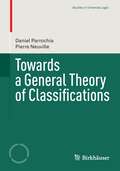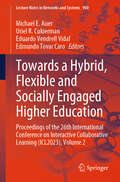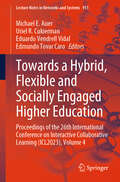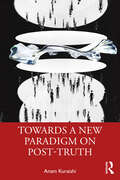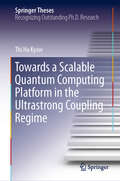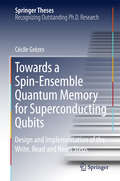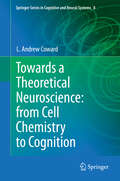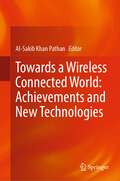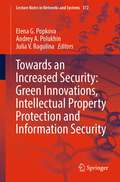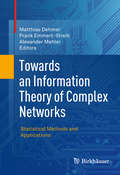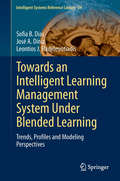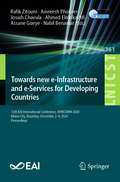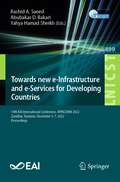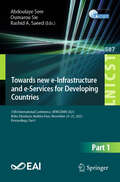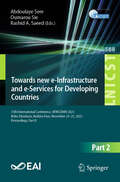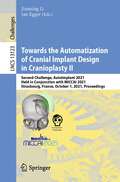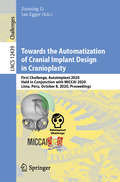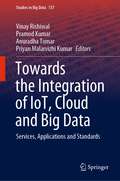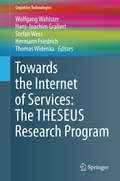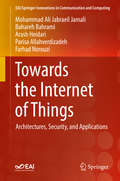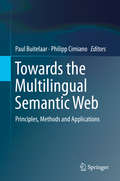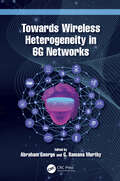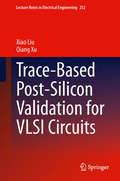- Table View
- List View
Towards a General Theory of Classifications
by Daniel Parrochia Pierre NeuvilleThis book is an essay on the epistemology of classifications. Its main purpose is not to provide an exposition of an actual mathematical theory of classifications, that is, a general theory which would be available to any kind of them: hierarchical or non-hierarchical, ordinary or fuzzy, overlapping or non-overlapping, finite or infinite, and so on, establishing a basis for all possible divisions of the real world. For the moment, such a theory remains nothing but a dream. Instead, the authors essentially put forward a number of key questions. Their aim is rather to reveal the "state of art" of this dynamic field and the philosophy one may eventually adopt to go further. To this end they present some advances made in the course of the last century, discuss a few tricky problems that remain to be solved, and show the avenues open to those who no longer wish to stay on the wrong track. Researchers and professionals interested in the epistemology and philosophy of science, library science, logic and set theory, order theory or cluster analysis will find this book a comprehensive, original and progressive introduction to the main questions in this field.
Towards a Hybrid, Flexible and Socially Engaged Higher Education: Proceedings of the 26th International Conference on Interactive Collaborative Learning (ICL2023), Volume 1 (Lecture Notes in Networks and Systems #899)
by Michael E. Auer Uriel R. Cukierman Eduardo Vendrell Vidal Edmundo Tovar CaroThis book contains papers in the fields of collaborative learning, digital transition in education, and AI and learning analytics in engineering education. The authors are currently witnessing a significant transformation in the development of education on all levels and especially in post-secondary education. To face these challenges, higher education must find innovative and effective ways to respond in a proper way. The pandemic period left us with profound changes in the way we teach and learn, including the massive use of new means of communication, such as videoconferencing and other technological tools. Moreover, the current explosion of artificial intelligence tools, mainly used by students, is challenging teaching practices maintained for centuries. Scientifically based statements as well as excellent best practice examples are absolutely necessary. The 26th International Conference on Interactive Collaborative Learning (ICL2023), which took place in Madrid, Spain, between September 26 and 30, 2023, was the perfect place where current trends in higher education were presented and discussed. Since its beginning in 1998, this conference has been devoted to new approaches in learning with a focus on collaborative learning in higher education. Nowadays, the ICL conferences are a forum of the exchange of relevant trends and research results as well as the presentation of practical experiences in learning and engineering pedagogy. In this way, the authors try to bridge the gap between ‘pure’ scientific research and the everyday work of educators. Interested readership includes policy makers, academics, educators, researchers in pedagogy and learning theory, schoolteachers, learning industry, further and continuing education lecturers, etc.
Towards a Hybrid, Flexible and Socially Engaged Higher Education: Proceedings of the 26th International Conference on Interactive Collaborative Learning (ICL2023), Volume 2 (Lecture Notes in Networks and Systems #900)
by Michael E. Auer Uriel R. Cukierman Eduardo Vendrell Vidal Edmundo Tovar CaroThis book contains papers in the fields of educational virtual environments, future of education, project-based learning (PBL), and digital education strategy and engineering pedagogy. The authors currently witnessing a significant transformation in the development of education on all levels and especially in post-secondary education. To face these challenges, higher education must find innovative and effective ways to respond in a proper way. The pandemic period left us with profound changes in the way we teach and learn, including the massive use of new means of communication, such as videoconferencing and other technological tools. Moreover, the current explosion of artificial intelligence tools, mainly used by students, is challenging teaching practices maintained for centuries. Scientifically based statements as well as excellent best practice examples are absolutely necessary. The 26th International Conference on Interactive Collaborative Learning (ICL2023), which took place in Madrid, Spain, between September 26 and 30, 2023, was the perfect place where current trends in higher education were presented and discussed. Since its beginning in 1998, this conference has been devoted to new approaches in learning with a focus on collaborative learning in higher education. Nowadays, the ICL conferences are a forum of the exchange of relevant trends and research results as well as the presentation of practical experiences in learning and engineering pedagogy. In this way, the authors try to bridge the gap between ‘pure’ scientific research and the everyday work of educators. Interested readership includes policy makers, academics, educators, researchers in pedagogy and learning theory, schoolteachers, learning industry, further and continuing education lecturers, etc.
Towards a Hybrid, Flexible and Socially Engaged Higher Education: Proceedings of the 26th International Conference on Interactive Collaborative Learning (ICL2023), Volume 3 (Lecture Notes in Networks and Systems #901)
by Michael E. Auer Uriel R. Cukierman Eduardo Vendrell Vidal Edmundo Tovar CaroThis book contains papers in the fields of engineering pedagogy education, research in engineering pedagogy, and games in engineering education. The authors are currently witnessing a significant transformation in the development of education on all levels and especially in post-secondary education. To face these challenges, higher education must find innovative and effective ways to respond in a proper way. The pandemic period left us with profound changes in the way we teach and learn, including the massive use of new means of communication, such as videoconferencing and other technological tools. Moreover, the current explosion of artificial intelligence tools, mainly used by students, is challenging teaching practices maintained for centuries. Scientifically based statements as well as excellent best practice examples are absolutely necessary. The 26th International Conference on Interactive Collaborative Learning (ICL2023), which took place in Madrid, Spain, between September 26 and 30, 2023, was the perfect place where current trends in higher education were presented and discussed. Since its beginning in 1998, this conference has been devoted to new approaches in learning with a focus on collaborative learning in higher education. Nowadays, the ICL conferences are a forum of the exchange of relevant trends and research results as well as the presentation of practical experiences in learning and engineering pedagogy. In this way, the authors try to bridge the gap between ‘pure’ scientific research and the everyday work of educators. Interested readership includes policy makers, academics, educators, researchers in pedagogy and learning theory, schoolteachers, learning industry, further and continuing education lecturers, etc.
Towards a Hybrid, Flexible and Socially Engaged Higher Education: Proceedings of the 26th International Conference on Interactive Collaborative Learning (ICL2023), Volume 4 (Lecture Notes in Networks and Systems #911)
by Michael E. Auer Uriel R. Cukierman Eduardo Vendrell Vidal Edmundo Tovar CaroWe are currently witnessing a significant transformation in the development of education on all levels and especially in post-secondary education. To face these challenges, higher education must find innovative and effective ways to respond in a proper way. The pandemic period left us with profound changes in the way we teach and learn, including the massive use of new means of communication, such as videoconferencing and other technological tools. Moreover, the current explosion of artificial intelligence tools, mainly used by students, is challenging teaching practices maintained for centuries. Scientifically based statements as well as excellent best practice examples are absolutely necessary.The 26th International Conference on Interactive Collaborative Learning (ICL2023), which will take place in Madrid, Spain, between 26th and 30th September 2023, will be the perfect place where to present and discuss current trends in Higher Education.Since its beginning in 1998 this conference is devoted to new approaches in learning with a focus on collaborative learning in Higher Education. Nowadays the ICL conferences are a forum of the exchange of relevant trends and research results as well as the presentation of practical experiences in Learning and Engineering Pedagogy. In this way we try to bridge the gap between ‘pure’ scientific research and the everyday work of educators.
Towards a New Paradigm on Post-truth
by Anam KuraishiThis book reconceptualises the idea of “post-truth”. It does not limit the domain of post-truth to the production factories of fake news. Drawing on examples such as Trump, War on Terror, anti-vaccination, climate change denial, denial of scientific facts about smoking, and so forth, it analyses the concept through a new theoretical lens which focuses on the specificity of post-truth discourses. Further, the volume develops a guide to operationalise post-truth discourse and makes use of Pakistan as a case study to illustrate post-truth discourses in Pakistani newspapers and implements an experiment to measure the effects of post-truth rhetoric on political attitudes.The volume will be essential reading for students, scholars, and researchers of media and communication studies, politics, and South Asian studies.
Towards a Scalable Quantum Computing Platform in the Ultrastrong Coupling Regime (Springer Theses)
by Thi Ha KyawThis thesis devotes three introductory chapters to outlining basic recipes for constructing the quantum Hamiltonian of an arbitrary superconducting circuit, starting from classical circuit design. Since a superconducting circuit is one of the most promising platforms for realizing a practical quantum computer, anyone who is starting out in the field will benefit greatly from this introduction. The second focus of the introduction is the ultrastrong light-matter interaction (USC), where the latest developments are described. This is followed by three main research works comprising quantum memory in USC; scaling up the 1D circuit to a 2D lattice configuration; creation of Noisy Intermediate-Scale Quantum era quantum error correction codes and polariton-mediated qubit-qubit interaction. The research work detailed in this thesis will make a major contribution to the development of quantum random access memory, a prerequisite for various quantum machine learning algorithms and applications.
Towards a Spin-Ensemble Quantum Memory for Superconducting Qubits
by Cécile GrèzesThis work describes theoretical and experimental advances towards the realization of a hybrid quantum processor in which the collective degrees of freedom of an ensemble of spins in a crystal are used as a multi-qubit register for superconducting qubits. A memory protocol made of write, read and reset operations is first presented, followed by the demonstration of building blocks of its implementation with NV center spins in diamond. Qubit states are written by resonant absorption of a microwave photon in the spin ensemble and read out of the memory on-demand by applying Hahn echo refocusing techniques to the spins. The reset step is implemented in between two successive write-read sequences using optical repumping of the spins.
Towards a Theoretical Neuroscience: from Cell Chemistry to Cognition
by L. Andrew CowardThe book explains how to understand cognition in terms of brain anatomy, physiology and chemistry, using an approach adapted from techniques for understanding complex electronic systems. These techniques create hierarchies of information process based descriptions on different levels of detail, where higher levels contain less information and can therefore describe complete cognitive phenomena, but are more approximate. The nature of the approximations are well understood, and more approximate higher level descriptions can therefore be mapped to more precise detailed descriptions of any part of a phenomenon as required. Cognitive phenomena, the anatomy and connectivity of major brain structures, neuron physiology, and cellular chemistry are reviewed. Various cognitive tasks are described in terms of information processes performed by different major anatomical structures. These higher level descriptions are selectively mapped to more detailed physiological and chemical levels.
Towards a Wireless Connected World: Achievements and New Technologies
by Al-Sakib Khan PathanThis book gathers key advances in various areas related to using wireless Internet and wireless connectivity to achieve a more connected world.The world is now highly dependent on Internet connectivity. Even though some parts of the globe remain isolated, the smoothly running world all around us relies on Internet services for countless businesses and activities. During the COVID-19 pandemic, we have seen that exclusively relying on wired Internet would leave out a large part of our tech-savvy world. Hence, wireless connectivity is essential to anywhere, anytime connectivity. Further, in the event of a new pandemic or other disaster of global scale, wireless Internet offers a reliable way to keep us all connected. The contributors to this book, hailing from academia, industrial and research laboratories, report on the latest solutions, trends and technologies with the potential to make wireless Internet more reliable and secure for the years to come.
Towards an Increased Security: Green Innovations, Intellectual Property Protection and Information Security (Lecture Notes in Networks and Systems #372)
by Elena G. Popkova Julia V. Ragulina Andrey A. PolukhinThis book aims to show that modern socio-economic and entrepreneurial systems are on the path to the increase of security and to determine the obstacles they face on this path, as well as determine the opportunities for overcoming these obstacles. The purpose of this book is to study new achievements in the sphere of the provision of security. The originality of this book consists in the development of the fundamental basis of the provision of modern socio-economic systems’ security through development and application of the new classification of the directions of provision of security—food and ecological, information and technological, and personnel and intellectual—and their systemic consideration.Five parts of this book elaborate on progressive green innovations in agriculture and the modern experience of food security provision; legal regulation of sustainable development and environmental security; economic security of regions and green innovations in natural resources management; technological security in the digital environment, data protection and information security; and security and the priority for personnel management and intellectual property protection.The target audience of this book are scholars, who will find in it the fundamental inventions and empirical studies of the international experience of security provision; representatives of public authorities, who will find in the book the recommendations on monitoring and regulation of food and ecological, information and technological, and personnel and intellectual security; and subjects of entrepreneurship, who will find in the book the applied solutions for corporate management of security.
Towards an Information Theory of Complex Networks: Statistical Methods and Applications
by Alexander Mehler Matthias Dehmer Frank Emmert-StreibFor over a decade, complex networks have steadily grown as an important tool across a broad array of academic disciplines, with applications ranging from physics to social media. A tightly organized collection of carefully-selected papers on the subject, Towards an Information Theory of Complex Networks: Statistical Methods and Applications presents theoretical and practical results about information-theoretic and statistical models of complex networks in the natural sciences and humanities. The book's major goal is to advocate and promote a combination of graph-theoretic, information-theoretic, and statistical methods as a way to better understand and characterize real-world networks. This volume is the first to present a self-contained, comprehensive overview of information-theoretic models of complex networks with an emphasis on applications. As such, it marks a first step toward establishing advanced statistical information theory as a unified theoretical basis of complex networks for all scientific disciplines and can serve as a valuable resource for a diverse audience of advanced students and professional scientists. While it is primarily intended as a reference for research, the book could also be a useful supplemental graduate text in courses related to information science, graph theory, machine learning, and computational biology, among others.
Towards an Intelligent Learning Management System Under Blended Learning
by Sofia B. Dias José A. Diniz Leontios J. HadjileontiadisWhat are the key channels to change in blended instructional practice as they relate to the use of a learning management system (LMS)? What role LMS users' profiles play in facilitating change in practice? Can we model users' quality of interaction (QoI) with LMS? How inclusiveness and affectiveness could lead to a personalized intelligent LMS (iLMS)? If these questions sound intrinsic to you and to your own experience and circumstance, then this book fits absolutely to you. Here, the term Blended - viewed as a fuzzy concept - is understood as a stepping-stone on the way to the future, to explain the multiple ways human beings think/act/feel of society in the 21st century and to embrace the opportunity of humans to re/co-construct new knowledge through the intermediation role of the technology. Initially, based on an online learning environment' theoretical framework, some current issues of the educational processes in the digital age of Web 2. 0 are analyzed. Then, after exploring the main methodological procedures, characteristic examples of research case studies follow, including LMS users' trends and profiles and modeling of their QoI using fuzzy logic. This book offers useful information that evokes initiatives towards rethinking of the value, efficiency, inclusiveness, affectiveness and personalization of the iLMS-based b-learning environment, both by the educators, the LMS designers and educational policy decision makers.
Towards new e-Infrastructure and e-Services for Developing Countries: 12th EAI International Conference, AFRICOMM 2020, Ebène City, Mauritius, December 2-4, 2020, Proceedings (Lecture Notes of the Institute for Computer Sciences, Social Informatics and Telecommunications Engineering #361)
by Assane Gueye Rafik Zitouni Amreesh Phokeer Josiah Chavula Ahmed Elmokashfi Nabil BenamarThis book constitutes the thoroughly refereed proceedings of the 12th International Conference on e-Infrastructure and e-Services for Developing Countries, AFRICOMM 2020, held in Ebène City, Mauritius, in December 2020. Due to COVID-19 pandemic the conference was held virtually. The 20 full papers were carefully selected from 90 submissions. The papers are organized in four thematic sections on dynamic spectrum access and mesh networks; wireless sensing and 5G networks; software-defined networking; Internet of Things; e-services and big data; DNS resilience and performance.
Towards new e-Infrastructure and e-Services for Developing Countries: 14th EAI International Conference, AFRICOMM 2022, Zanzibar, Tanzania, December 5-7, 2022, Proceedings (Lecture Notes of the Institute for Computer Sciences, Social Informatics and Telecommunications Engineering #499)
by Rashid A. Saeed Abubakar D. Bakari Yahya Hamad SheikhThis book constitutes the refereed proceedings of the 14th EAI International Conference on Towards new e-Infrastructure and e-Services for Developing Countries, AFRICOMM 2022, which was held in Zanzibar, Tanzania, in December 2022.The 30 papers presented in this volume were carefully reviewed and selected from 78 submissions. The papers are organized in the following topical sections: E-infrastructure; E-Services (Farming); E-Services (Health); E-Services (Social); E-Services (Education); and Advanced ICT.
Towards new e-Infrastructure and e-Services for Developing Countries: 15th International Conference, AFRICOMM 2023, Bobo-Dioulasso, Burkina Faso, November 23–25, 2023, Proceedings, Part I (Lecture Notes of the Institute for Computer Sciences, Social Informatics and Telecommunications Engineering #587)
by Oumarou Sie Rashid A. Saeed Abdoulaye SereThe two-volume set LNICST 587 + 588 constitutes the refereed proceedings of the EAI 15th International Conference on nternational Conference on e-Infrastructure and e-Services for Developing Countries, AFRICOMM 2023, which took place in Bobo-Dioulasso, Burkina Faso, in November 2023. The 59 full papers presented in these two volumes were carefully reviewed and selected from 72 submissions. The papers are organized in the following topical sections: Part I: Digital economy, Digital transformation, e-Government and e-services; ICT infrastructures for critical environmental conditions; Wireless networks; E-health; Cybersecurity and Privacy. Part II: Systems and cloud computing; Artificial Intelligence; Ontology and data preparation; Responsible Artificial Intelligence for Sustainable Development in Africa (workshop).
Towards new e-Infrastructure and e-Services for Developing Countries: 15th International Conference, AFRICOMM 2023, Bobo-Dioulasso, Burkina Faso, November 23–25, 2023, Proceedings, Part II (Lecture Notes of the Institute for Computer Sciences, Social Informatics and Telecommunications Engineering #588)
by Oumarou Sie Rashid A. Saeed Abdoulaye SereThe two-volume set LNICST 587 + 588 constitutes the refereed proceedings of the EAI 15th International Conference on Africa Internet infrastructure and Services, AFRICOMM 2023, which took place in Bobo-Dioulasso, Burkina Faso, in November 2023. The 59 full papers presented in these two volumes were carefully reviewed and selected from 72 submissions. The papers are organized in the following topical sections: Part I: Digital economy, Digital transformation, e-Government and e-services; ICT infrastructures for critical environmental conditions; Wireless networks; E-health; Cybersecurity and Privacy. Part II: Systems and cloud computing; Artificial Intelligence; Ontology, data preparation; Responsible Artificial Intelligence for Sustainable Development in Africa (workshop).
Towards the Automatization of Cranial Implant Design in Cranioplasty II: Second Challenge, AutoImplant 2021, Held in Conjunction with MICCAI 2021, Strasbourg, France, October 1, 2021, Proceedings (Lecture Notes in Computer Science #13123)
by Jan Egger Jianning LiThis book constitutes the Second Automatization of Cranial Implant Design in Cranioplasty Challenge, AutoImplant 2021, which was held in conjunction with the 24th International Conference on Medical Image Computing and Computer-Assisted Intervention, MICCAI 2021, in Strasbourg, France, in September, 2021. The challenge took place virtually due to the COVID-19 pandemic. The 7 papers are presented together with one invited paper, one qualitative evaluation criteria from neurosurgeons and a dataset descriptor. This challenge aims to provide more affordable, faster, and more patient-friendly solutions to the design and manufacturing of medical implants, including cranial implants, which is needed in order to repair a defective skull from a brain tumor surgery or trauma. The presented solutions can serve as a good benchmark for future publications regarding 3D volumetric shape learning and cranial implant design.
Towards the Automatization of Cranial Implant Design in Cranioplasty: First Challenge, AutoImplant 2020, Held in Conjunction with MICCAI 2020, Lima, Peru, October 8, 2020, Proceedings (Lecture Notes in Computer Science #12439)
by Jan Egger Jianning LiThis book constitutes the First Automatization of Cranial Implant Design in Cranioplasty Challenge, AutoImplant 2020, which was held in conjunction with the 23rd International Conference on Medical Image Computing and Computer-Assisted Intervention, MICCAI 2020, in Lima, Peru, in October 2020. The challenge took place virtually due to the COVID-19 pandemic.The 10 papers presented together with one invited paper and a dataset descriptor in this volume were carefully reviewed and selected form numerous submissions. This challenge aims to provide more affordable, faster, and more patient-friendly solutions to the design and manufacturing of medical implants, including cranial implants, which is needed in order to repair a defective skull from a brain tumor surgery or trauma. The presented solutions can serve as a good benchmark for future publications regarding 3D volumetric shape learning and cranial implant design.
Towards the Integration of IoT, Cloud and Big Data: Services, Applications and Standards (Studies in Big Data #137)
by Pramod Kumar Anuradha Tomar Vinay Rishiwal Priyan Malarvizhi KumarThis book discusses integration of internet of things (IoT), cloud computing, and big data. It presents a unique platform where IoT, cloud computing, and big data are fused together and can be foreseen as a perfect solution to many applications. Usually, IoT, cloud computing, and big data are researched separately on the basis of their properties, underlying technologies, and other open issues. Integration of IoT, cloud computing and big data is not that easy and can face key open issues like standardization of interfaces, power and energy efficiency in both data processing and transmission, security and privacy, storage mechanisms for future applications, scalability and flexibility, and QoS provisioning for end user applications. Integration of IoT, cloud computing, and big data represents the next big rise for future industry and business applications. This integration opens new exhilarating directions for research and it is discussed in this book.
Towards the Internet of Services: The THESEUS Research Program
by Wolfgang Wahlster Hans-Joachim Grallert Stefan Wess Hermann Friedrich Thomas WidenkaThe Internet of Services and the Internet of Things are major building blocks of the Future Internet. The digital enterprise of the future is based not only on mobile, social, and cloud technologies, but also on semantic technologies and the future Internet of Everything. Semantic technologies now enable mass customization for the delivery of goods and services that meet individual customer needs and tastes with near mass production efficiency and reliability. This is creating a competitive advantage in the industrial economy, the service economy, and the emerging data economy, leading to smart products, smart services, and smart data, all adaptable to specific tasks, locations, situations, and contexts of smart spaces. Such technologies allow us to describe, revise, and adapt the characteristics, functions, processes, and usage patterns of customization targets on the basis of machine-understandable content representation that enables automated processing and information sharing between human and software agents. This book explains the principal achievements of the Theseus research program, one of the central programs in the German government's Digital 2015 initiative and its High-Tech Strategy 2020. The methods, toolsets, and standards for semantic technologies developed during this program form a solid basis for the fourth industrial revolution (Industrie 4. 0), the hybrid service economy, and the transformation of big data into useful smart data for the emerging data economy. The contributing authors are leading scientists and engineers, representing world-class academic and industrial research teams, and the ideas, technologies, and representative use cases they describe in the book derive from results in multidisciplinary fields, such as the Internet of Services; the Semantic Web, and semantic technologies, knowledge management, and search; user interfaces, multimodal interaction, and visualization; machine learning and data mining; and business process support, manufacturing, automation, medical systems, and integrated service engineering. The book will be of value to both researchers and practitioners in these domains.
Towards the Internet of Things: Architectures, Security, and Applications (EAI/Springer Innovations in Communication and Computing)
by Mohammad Ali Jabraeil Jamali Bahareh Bahrami Arash Heidari Parisa Allahverdizadeh Farhad NorouziThis book presents a comprehensive framework for IoT, including its architectures, security, privacy, network communications, and protocols. The book starts by providing an overview of the aforementioned research topics, future directions and open challenges that face the IoT development. The authors then discuss the main architectures in the field, which include Three- and Five-Layer Architectures, Cloud and Fog Based Architectures, a Social IoT Application Architecture. In the security chapter, the authors outline threats and attacks, privacy preservation, trust and authentication, IoT data security, and social awareness. The final chapter presents case studies including smart home, wearables, connected cars, industrial Internet, smart cities, IoT in agriculture, smart retail, energy engagement, IoT in healthcare, and IoT in poultry and farming.Discusses ongoing research into the connection of the physical and virtual worlds;Includes the architecture, security, privacy, communications, and protocols of IoT;Presents a variety of case studies in IoT including wearables, smart cities, and energy management.
Towards the Multilingual Semantic Web
by Paul Buitelaar Philipp CimianoTo date, the relation between multilingualism and the Semantic Web has not yet received enough attention in the research community. One major challenge for the Semantic Web community is to develop architectures, frameworks and systems that can help in overcoming national and language barriers, facilitating equal access to information produced in different cultures and languages. As such, this volume aims at documenting the state-of-the-art with regard to the vision of a Multilingual Semantic Web, in which semantic information will be accessible in and across multiple languages. The Multilingual Semantic Web as envisioned in this volume will support the following functionalities: (1) responding to information needs in any language with regard to semantically structured data available on the Semantic Web and Linked Open Data (LOD) cloud, (2) verbalizing and accessing semantically structured data, ontologies or other conceptualizations in multiple languages, (3) harmonizing, integrating, aggregating, comparing and repurposing semantically structured data across languages and (4) aligning and reconciling ontologies or other conceptualizations across languages. The volume is divided into three main sections: Principles, Methods and Applications. The section on "Principles" discusses models, architectures and methodologies that enrich the current Semantic Web architecture with features necessary to handle multiple languages. The section on "Methods" describes algorithms and approaches for solving key issues related to the construction of the Multilingual Semantic Web. The section on "Applications" describes the use of Multilingual Semantic Web based approaches in the context of several application domains. This volume is essential reading for all academic and industrial researchers who want to embark on this new research field at the intersection of various research topics, including the Semantic Web, Linked Data, natural language processing, computational linguistics, terminology and information retrieval. It will also be of great interest to practitioners who are interested in re-examining their existing infrastructure and methodologies for handling multiple languages in Web applications or information retrieval systems.
Towards Wireless Heterogeneity in 6G Networks
by Abraham George G. Ramana MurthyThe connected world paradigm effectuated through the proliferation of mobile devices, Internet of Things (IoT), and the metaverse will offer novel services in the coming years that need anytime, anywhere, high-speed access. The success of this paradigm will highly depend on the ability of the devices to always obtain the optimal network connectivity for an application and on the seamless mobility of the devices. This book will discuss 6G concepts and architectures to support next-generation applications such as IoT, multiband devices, and high-speed mobile applications. IoT applications put forth significant challenges on the network in terms of spectrum utilization, latency, energy efficiency, large number of users, and supporting different application characteristics in terms of reliability, data rate, and latency.While the 5G network developmentwas motivated by the need for larger bandwidth and higher quality of service (QoS), 6G considerations are supporting many users with a wide application requirement, lowering network operating cost, and enhanced network flexibility. Network generations beyond 5G are expected to accommodate massive number of devices with the proliferation of connected devices concept in connected cars, industrial automation, medical devices, and consumer devices.This book will address the fundamental design consideration for 6G networks and beyond. There are many technical challenges that need to be explored in the next generation of networks, such as increased spectrum utilization, lower latency, higher data rates, accommodating more users, heterogeneous wireless connectivity, distributed algorithms, and device-centric connectivity due to diversified mobile environments and IoT application characteristics. Since 6G is a multidisciplinary topic, this book will primarily focus on aspects of device characteristics, wireless heterogeneity, traffic engineering, device-centric connectivity, and smartness of application.
Trace-Based Post-Silicon Validation for VLSI Circuits
by Xiao Liu Qiang XuThis book first provides a comprehensive coverage of state-of-the-art validation solutions based on real-time signal tracing to guarantee the correctness of VLSI circuits. The authors discuss several key challenges in post-silicon validation and provide automated solutions that are systematic and cost-effective. A series of automatic tracing solutions and innovative design for debug (DfD) techniques are described, including techniques for trace signal selection for enhancing visibility of functional errors, a multiplexed signal tracing strategy for improving functional error detection, a tracing solution for debugging electrical errors, an interconnection fabric for increasing data bandwidth and supporting multi-core debug, an interconnection fabric design and optimization technique to increase transfer flexibility and a DfD design and associated tracing solution for improving debug efficiency and expanding tracing window. The solutions presented in this book improve the validation quality of VLSI circuits, and ultimately enable the design and fabrication of reliable electronic devices.
